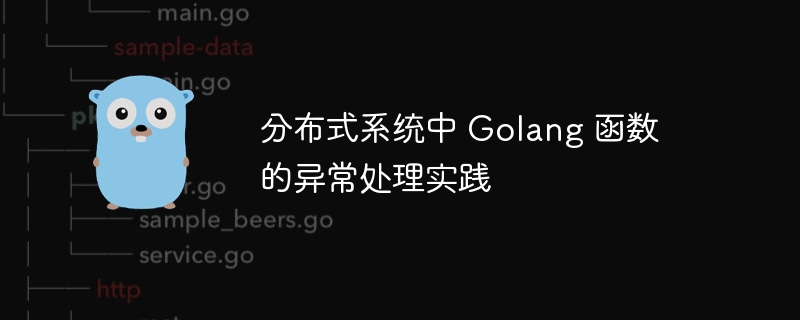
Exception handling in Golang distributed system uses the errgroup package, which provides concurrent error groups. In the practical case, an errgroup with context is created through errgroup.WithContext, and g.Go is used to concurrently execute goroutines for multiple simulation tasks. If any goroutine encounters an error, the errgroup will return the error, captured and logged in the main function. By using the errgroup package, the system does not crash when an error is encountered, allowing errors to be handled and logged gracefully.

Exception handling practice of Golang functions in distributed systems
Background
In distributed systems, exception handling is crucial. An unhandled exception can cause the entire system to crash, with serious consequences. Therefore, it is important to implement an effective and robust exception handling strategy.
Exception handling in Golang
Golang uses the errgroup package for exception handling. This package provides concurrent error groups that can be used to manage multiple An error occurred in a goroutine.
Practical Case
Let us use a simple example to understand how to handle exceptions in the Golang distributed system:
package main
import (
"context"
"errors"
"fmt"
"log"
"sync"
"sync/errgroup"
)
func main() {
g, ctx := errgroup.WithContext(context.Background())
var wg sync.WaitGroup
// 定义一个 goroutine 用来模拟任务
taskFunc := func() error {
wg.Add(1)
defer wg.Done()
// 模拟一个错误场景
return errors.New("模拟错误")
}
for i := 0; i < 10; i++ {
g.Go(taskFunc)
}
if err := g.Wait(); err != nil {
// 如果任何 goroutine 遇到错误,则 errgroup 将返回该错误
log.Fatal(err)
}
wg.Wait()
fmt.Println("所有任务完成,没有遇到错误")
}In this case , we created a sync.WaitGroup to track the number of goroutines, and used errgroup.WithContext to create an errgroup with context. We then define a taskFunc function that simulates a task and returns an error within it. Finally, we use g.Go to execute multiple taskFunc concurrently.
If any goroutine encounters an error, errgroup will return that error. In our main function, we catch the error and log it using log.Fatal. Before wait, we use sync.WaitGroup to wait for all tasks to complete.
Conclusion
By using the errgroup package, we can easily handle exceptions in Golang distributed systems. This approach helps ensure that the system does not crash when encountering errors and allows us to handle and log these errors gracefully.
The above is the detailed content of Exception handling practice of Golang functions in distributed systems. For more information, please follow other related articles on the PHP Chinese website!
 How to define variables in golang
How to define variables in golang
 What are the data conversion methods in golang?
What are the data conversion methods in golang?
 What are the commonly used libraries in golang?
What are the commonly used libraries in golang?
 What is the difference between golang and python
What is the difference between golang and python
 Characteristics of relational databases
Characteristics of relational databases
 How to turn on and off Douyin Xiaohuoren
How to turn on and off Douyin Xiaohuoren
 Taobao password-free payment
Taobao password-free payment
 What should I do if the itinerary card cannot be opened?
What should I do if the itinerary card cannot be opened?
 what is python programming
what is python programming




